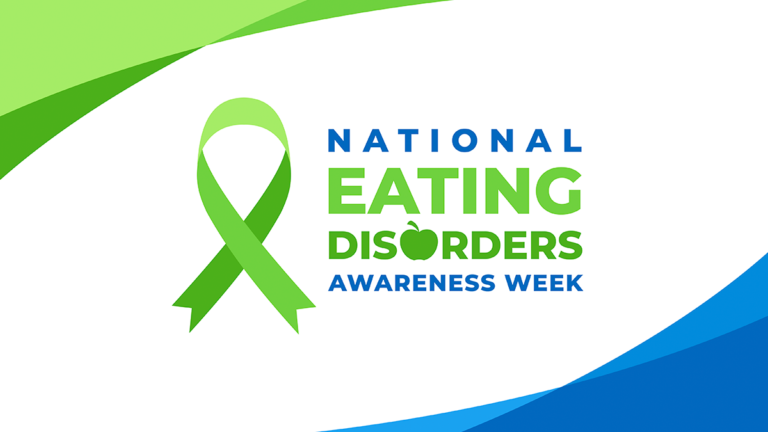From February 26 to March 3, 2024, we recognize National Eating Disorder Awareness Week, a moment to recommit to showing compassion and empowering our fellow Americans affected by eating disorders. This is also the time to demonstrate our commitment to early diagnosis and effective treatment of eating disorders. Eating disorders are a serious public health concern, as it is estimated that twenty-nine million Americans—or 9 percent of the population—will have an eating disorder in their lifetime.1 Over 10,000 people die annually due to an eating disorder, and the economic cost of eating disorders is nearly $65 billion annually.2
Eating disorders include binge eating disorder, anorexia, bulimia nervosa, other specified feeding or eating disorder (OSFED), restrictive food intake avoidance disorder (ARFID), pica disorder, and rumination.
There are a variety of genetic, biological, psychological, and social factors associated with the development of an eating disorder. 3, 4, 5
Disparities in Eating Disorders
People of all income levels, races, ethnicities, sexual orientations and gender identities, and body sizes can be affected by an eating disorder. The prevalence of eating disorders is similar or even higher among nonwhites than among whites.6, 7 Almost 30 percent of people with eating disorders are men, yet men are 4.6 times less likely to be diagnosed with an eating disorder than women.8 Eating disorders are more common in sexual minorities and sexual minorities than cisgender heterosexuals for all eating disorders.9, 10, 11
Eating disorders can develop in people of any body size. In fact, only 6 percent of those with eating disorders are underweight.12 It is well documented that people who experience weight stigma—that is, discrimination because of their weight—are more likely to exhibit disordered eating behaviors than those who do not experience such discrimination.13, 14
Treatment for Eating Disorders
Eating disorders require not only psychological support, but also medical, nutritional and psychiatric care. For pediatric patients, the use of family therapy is considered the gold standard.15
Available resources
Through SAMHSA funding for National Center of Excellence for Eating Disorders (NCEED)expand access to new tools and training for health care providers, families, caregivers and community members so they can better identify and support people with eating disorders.
If you or a loved one needs support for an eating disorder, visit FindSupport.gov or call the SAMHSA National Helpline at 1-800-662-4357 for confidential, toll-free, 24 hours a day, 365 days a year information and referral services. For anyone experiencing a crisis, immediate and confidential help is also available by calling or texting 988, the National Suicide and Crisis Line.
1Deloitte Access Economics. The Social and Economic Costs of Eating Disorders in the United States of America: A Report for the Eating Disorders Prevention Strategic Education Initiative and the Eating Disorders Academy. June 2020.
3Rodríguez Martín, A., Novalbos Ruiz, J., Martínez Nieto, J. et al. Epidemiological study of the effect of family and socioeconomic status on eating disorders. Eur J Clin Nutr 58, 846–852 (2004).
4Burke, N., Hazzard, V., Schaefer, L., Simone, M., O’Flynn, J., & Rodgers, R. (2022). Socioeconomic Status and Eating Disorder Prevalence: At the Intersections of Gender, Sexual Orientation, and Race/Ethnicity. Psychological Medicine, 1-11.
5Cheng, ZH, Perko, VL, Fuller-Marashi, L., Gau, JM, & Stice, E. (2019). Ethnic differences in eating disorder prevalence, risk factors, and predictive effects of risk factors among young women. Nutritional Behaviors, 32, 23–30.
6Edwards, JB., Franko, DL. Cultural issues in eating pathology and body image among children and adolescentsJournal of Pediatric Psychology, Volume 35, Issue 3, April 2010, Pages 231–242.
7Franko, DL, Becker, AE, Thomas, JJ, & Herzog, DB (2007). Cross-ethnic differences in eating disorder symptoms and related distress. International Journal of Eating Disorders, 40(2), 156–164.
8Sonneville, KR, Lipson, SK. Disparities in eating disorder diagnosis and treatment by weight status, race/ethnicity, socioeconomic background, and gender among college students. Int J Eat Disord. 2018? 51: 518-526
9Calzo, JP, Blashill, AJ, Brown, TA Eating disorders and disturbed weight and shape control behaviors in sexual minority populations. Curr Psychiatry Rep 19, 49 (2017).
10Kamody, RC, Grilo, CM, Udo, T. Differences in DSM-5 Defined Eating Disorders Based on Sexual Orientation Among US Adults. Int J Eat Disord. 2020? 53: 278-287.
11Rasmussen SM, Dalgaard MK, Roloff M, Pinholt M, Skrubbeltrang C, Clausen L, Kjaersdam Telléus G. Eating disorder symptomatology among transgender people: a systematic review and meta-analysis. J Eat Disord. 2023 May 26 11(1):84. PMID: 37237320; PMCID: PMC10214585.
12Flament, M., Henderson, K., Buchholz, A., Obeid, N., Nguyen, H., Birmingham, M., Goldfield, G. (2015). Weight Status and DSM-5 Eating Disorder Diagnoses in Adolescents from the Community. Journal of the American Academy of Child & Adolescent Psychiatry, Vol. 54, Issue 5, 403-411.
13Puhl, R., Suh, Y. Health consequences of weight stigma: Implications for obesity prevention and treatment. Curr Obes Rep 4, 182–190 (2015).
14Jess Haines, Dianne Neumark-Sztainer, Marla E. Eisenberg, Peter J. Hannan; Weight teasing and disordered eating behaviors in adolescents: Longitudinal findings from the Eating Among Teens (EAT) project. Pediatrics February 2006; 117 (2): e209–e215.
15Alberga, AS, Edache, IY, Forhan, M., & Russell-Mayhew, S. (2019). Weight bias and health care utilization: a scoping review. Primary Health Care Research & Development, 20, e116.
Citations are based on a comprehensive search using PubMed and, where relevant, multiple sources are cited to minimize any potential bias and further support the credibility of commonly understood facts in the literature.
